How to Create a Transaction Envelope for Corporate Key2Purchase Card Holders
Step 1: Log into Key2Purchase.com
- The Organization ID for Hamilton College is THC.
- Each time you login on a new device or after you clear your browser history, you will be required to enter a security code. The security code will be sent to your Hamilton email account. (Reminder we do not use your SSN, in place we use Hamilton Employee ID with two lead zeros).
Step 2: Create a transaction envelope
- Select Create a Transaction Envelope from Quick Links section on the right hand side of the home page or go to transactions, transaction envelope, create.
- The following screen will be displayed. Select your card number under the My Cards section.
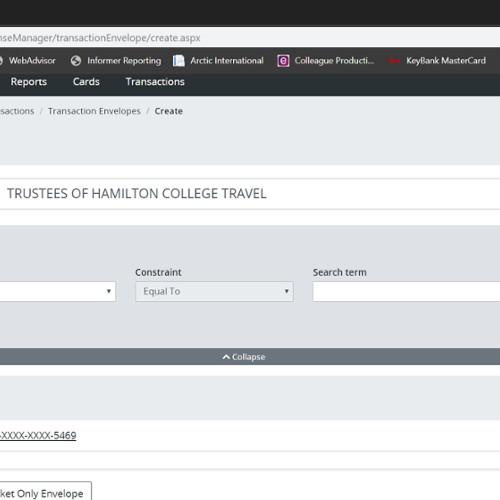
- Once you select your card number, you will be brought to the envelope create screen.
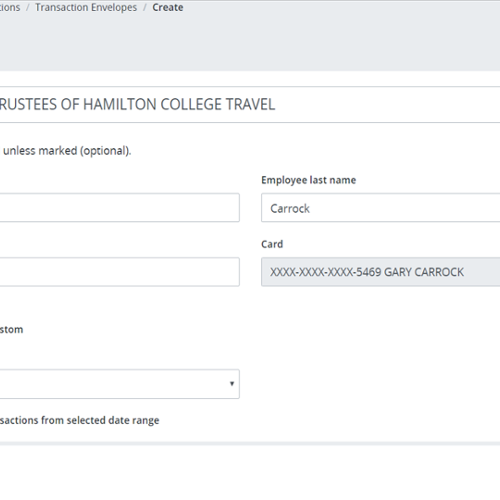
- Make sure the Organization is for the profile your card is setup with Trustees of Hamilton College Travel (for travel & VP cards) or Trustees of Hamilton College PCARD (for purchasing cards). If not, use the drop down selection box to change.
- Enter a name for the envelope. The name should be the Month and year, if you need to label with more detail please do so after the year.
- Select the date range: Cycle
- At least one transaction envelope is required to be submitted for each billing cycle.
- Some travelers will want to prepare an envelope for the period corresponding with their statement cycle. This is the preferred method.
- For a custom period, select Custom under Date Range and you will be prompted to enter begin and end dates for the envelope. (This date cannot exceed the billing cycle dates). Envelopes for this method should still be labeled Month Year any other information can be added after year.
- The option to autofill envelope with transactions should be flagged so that all card transactions for the period are automatically included in the transaction envelope.
-
Click Save.
Step 3: Review and code your transactions
- Upon saving your envelope, you will be sent to review and code your Transactions.
- If you scroll down the screen, all transactions posted to your card within the date cycle selected will be displayed.
- All of these transactions will be automatically entered into your envelope. They will be noted by a check box listed under the In Envelope column, as seen below.
- A default cost center may be prefilled, but can be modified by entering new codes or selecting from the drop down box, which is displayed by clicking Add.
- Default cost centers may be selected when applying for a credit card or by providing your preferred default cost center to Amanda Gleasman via email agleasma@hamilton.edu.
- An object code (expense) must be added and this may be done by entering the four-digit code or by clicking Add and selecting from the drop box.
- Complete the Notes section with a description of the charge.
- Save your progress by selecting the Save button at the bottom of the page. If you do not get a successful saved message, review for errors. (most common or GL/budget number not active)
- Repeat this process for each transaction.
- Transactions may be charged to more than one account by highlighting the transaction and then selecting Split Transactions. Follow instructions once select split transactions.
Step 4: Create out of pocket transactions (if applicable)
Out of pocket expenses are those that the cardholder paid for and should be reimbursed. Example the card was declined and used personal card.
Key2Purchase cardholders are now required to submit any out of pocket expenses through the KEY system, travel expense reports or check requests through Accounts Payable are not accepted for KEY cardholders. Out of pocket expenses can be added to their monthly transaction envelopes (this is to be done in the current envelope, please do not create a separate envelope).
- Envelopes must be approved by your supervisor for prompt payment.
- Payments of these expenses will be paid approximately one to two weeks after approved.
To create a transaction, select the Create Out of Pocket Transaction button as seen below.
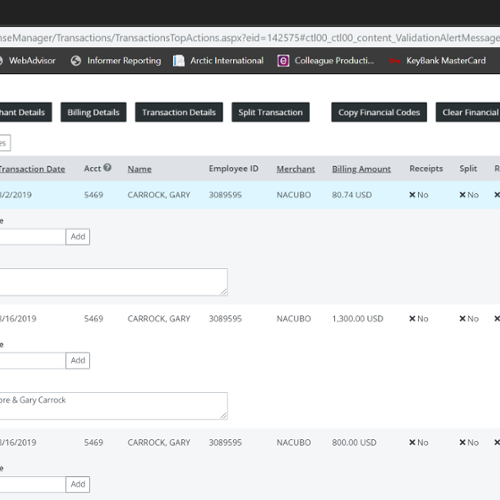
- The following screen will be displayed.
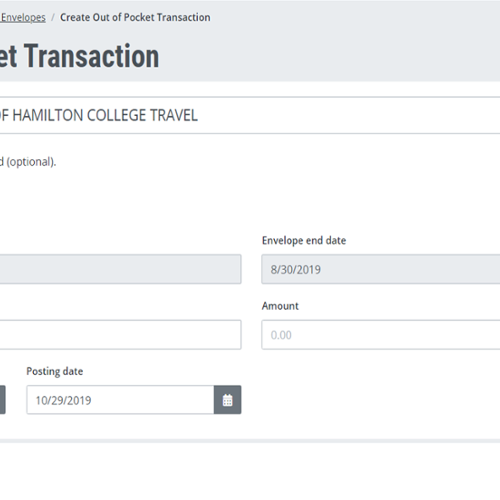
- If the Out of Pocket expense is not for mileage, enter relevant information and click Save.
- If the out of pocket transaction is for mileage, select Calculated and then enter the number of miles.
- Click Save and the system will calculate the appropriate dollar reimbursement.
- This process may be completed for several Out of Pocket expenses.
Step 5: Addressing personal charges
If any portion of the transactions charged to your travel card were for personal rather than business:
- Reimbursements owed to the College need to be resolved before the next statement cycle
- Payments should be delivered to Amanda Gleasman with:
- Accompanying information to detail the exact transaction that was personal
- A completed deposit slip indicating the budget to which the transaction was charged.
- Checks can be made out to Trustees of Hamilton College
- To reconcile the statement, use cost center 100000001 and object code 2410 with note personal use ck sent to Business Office
- Payments should be delivered to Amanda Gleasman with:
If you have personal and out of pocket charges any personal should be netted out of the travel expense report by entering a negative amount using the same account number used for the transaction in the envelope. These amounts will offset the amount owed to you. For Example:
Purchase at Target card used corporate card in error $150.00
Per diem for 3 days meeting in North Carolina -$150.00
Step 6: Uploading Receipts
- Substantiating receipts must be uploaded for any card transaction of $20 or more. If the only transaction is under $20 receipt is required to process envelope. The $20 is Business Office guidelines; some departments require all receipts regardless of the amount. Please confirm with your Supervisor/Manager.
- If travelers are requesting the meal per diem, substantiating receipts are not required.
- Original receipts showing what was purchased (rather than simple credit card receipts indicating a total amount) are required.
- Travelers may save each receipt as a separate pdf or may save copies of multiple paper receipts as a single pdf.
In order to upload receipts, select Receipts from options shown at the bottom of the screen.
- You will be prompted to browse and then upload.
- A message will be displayed when the receipt has been successfully uploaded as shown below.
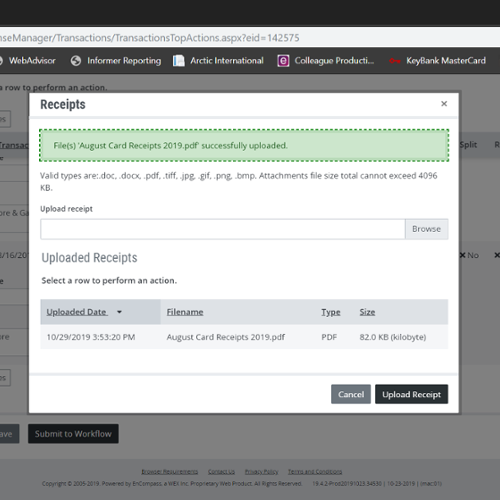
- Key Bank allows for several different file types that can be uploaded to a transaction envelope, as shown on the graphic above.
- There is also a maximum file size limit on each upload. The file size may not exceed 4096 KB.
- When scanning receipts it is helpful to use a lower picture quality to create a smaller file for upload.
- If your files exceed the file size limit then separate upload instances will be required.
Step 7: Submitting your envelope for approval
You may wish to print or save a copy of your completed envelope (travel expense report) for your records.
- Click on Print Envelope at the bottom of the screen.
- A screen will pop up allowing you to format the layout and include receipts, as shown below
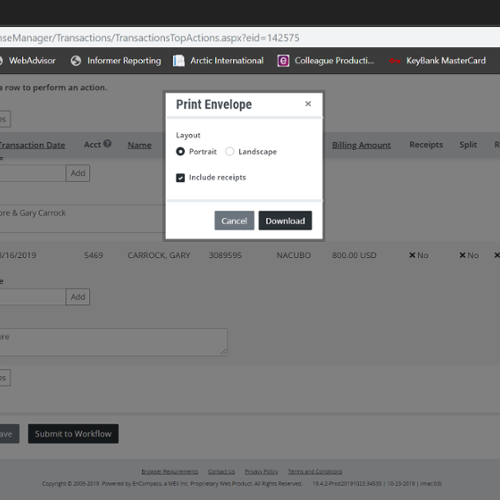
- Click on download to save your file.
When you are ready to submit the transaction envelope for online approval, select Submit to Workflow.
- The system will display an error statement if the envelope contains errors such as no object code.
- Otherwise, a message will be displayed that the envelope has been successfully submitted.
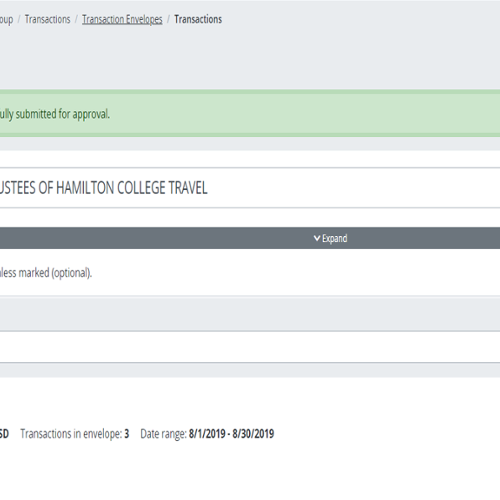
- Your supervisor will receive an email notification to approve your envelope online.
Contact
Contact Name
Business Office
